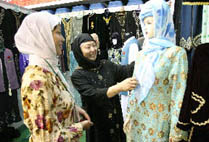| Tradition and Modernity:The Life of the Hui People in Ningxia Preserving Hui Culture
By staff reporter LU RUCAI
It is 9 o'clock in the morning, and the staff of the Halal Food and Islamic Culture City are preparing for the store’s opening. It is a department store, exhibiting and selling Halal food and traditional Muslim commodities. Located in Xingqing District of Yinchuan City, capital of Ningxia Hui Autonomous Region, the store was opened in the first half of 2008. A 20-year-old salesgirl, Ding Ling, is busy demonstrating a kouxian, a unique Hui musical instrument, to visitors. “Actually I barely know how to play it,” she says with a shy smile.
 |
|
Muslim costumes made by the Tongxin Tongda Co., Ltd. are widely adored by Muslim people. |
Ding lives in a Hui community near the store. Her parents earn a living by helping transport goods. “We all speak Mandarin in our family,” Ding explains. Although she practices Islam, she could not speak Arabic at all before she started to learn it at the Ningxia Islamic Institute.
“I only hear some Arabic while my parents are reading scripture at home, but I can’t speak it. Most young Hui people like me never speak Arabic,” she says. “Even our parents do not thoroughly understand the scriptures they read. They learn them from imams in mosques.”
On the first floor of the department store is the Folk Custom Exhibition Hall, which displays all sorts of Hui handicrafts, such as costumes, tableware, tea sets, carpets, tapestries, embroideries and papercuts. On the second floor is the Halal Food Exhibition Hall, with various Halal foods, tonics and folk medicines. According to Wang Yan, who is in charge of the floor, they have received visitors from over 10 countries in less than half a year since it opened, mostly from the Middle East.
Furs, eight-treasure tea, Chinese wolfberry and Halal foods are popular choices for these visitors. “Embroideries made by the Hui are quite different from those made by the Han,” says Wang. “Instead of doing embroidery and papercuts of people’s images, Hui artists often prefer flowers and plants. This has its roots in their environment. Even if they make works of people’s images, they prefer to use images of Hui girls.” All the displayed embroideries and other crafts are handmade and were purchased from Hui women in southern mountainous areas.
Zhang Wei, an official in the region’s publicity department, says that before coming to Ningxia, many people take it for granted that the Hui look different from the Han. In fact, you can hardly distinguish the faith and customs of the locals from their appearance and language. Ding Ling tells China Today that most young people here do not wear folk costumes, even at home. Only older Hui men wear Muslim prayer caps, and older women wear veils.
|
